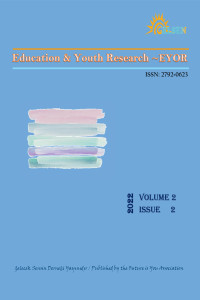An Investigation of Dance Based Aquatic and Zumba Exercise in Sedentary Women According to Motoric and Physiological Parameters
Öz
The aim of the study was to examine the effects of zumba and aquatic exercises on anthropometric and motoric features in sedentary women. The study consists of 60 sedentary women (age Avg.= 41.90 ± 8.75), 30 of which are an aquatic exercise group and 30 zumba exercise group who regularly participated in Zumba and Aquatic exercises three days a week during the study. The body composition analysis was determined by using the bioelectrical impedance method. The body mass (kg) and height, waist, hip, chest, thigh circumference measurements, and bio-motor characteristics of flexibility and balance measurements were performed pre and post of the study for all subjects. Paired sample t-test and Wilcoxon signed-rank test were used as statistical analysis. When the pre-and post-exercise values of the groups were compared, in body weight, body mass index, fat-free mass (FFM), flexibility, balance, fat mass, chest, hip, waist circumference, and body fat %, it was found statistically significant differences among all these parameters in the aquatic exercise group. In Zumba exercise group; a statistically significant difference was found between the women's body weight, BMI, FFM, flexibility, balance, fat mass, chest, hip, waist circumference, and body fat percentage (BF%) measurements. When the groups were compared, significant differences were found in the parameters of FFM, fat mass, flexibility, and balance.
Kaynakça
- Cugusi. L.. Manca. A.. Bergamin. M.. Blasio. A. D.. Yeo T. J.. Crisafulli. A.. Mercuro. G. (2019). Zumba fitness and women's cardiovascular health: a systematıc review. Journal of Cardiopulmonary Rehabilitation and Prevention. 39(3). 153-160. doi: 10.1097/HCR.0000000000000326.
- Raffaelli. C.. Milanese. C.. Lanza. M.. and Zamparo. P. (2016). Water-based training enhances both physical capacities and body composition in healthy young adult women. Sport Sciences for Health. 12(2). 195-207.
Dans Temelli Akuatik ve Zumba Egzersizinin Sedanter Kadınlarda Motorik ve Fizyolojik Parametrelere Göre İncelenmesi
Öz
The aim of the study was to examine the effects of zumba and aquatic exercises on anthropometric and motoric features in sedentary women. The study consists of 60 sedentary women (age Avg.= 41.90 ± 8.75), 30 of which are an aquatic exercise group and 30 zumba exercise group who regularly participated in Zumba and Aquatic exercises three days a week during the study. The body composition analysis was determined by using the bioelectrical impedance method. The body mass (kg) and height, waist, hip, chest, thigh circumference measurements, and bio-motor characteristics of flexibility and balance measurements were performed pre and post of the study for all subjects. Paired sample t-test and Wilcoxon signed-rank test were used as statistical analysis. When the pre-and post-exercise values of the groups were compared, in body weight, body mass index, fat-free mass (FFM), flexibility, balance, fat mass, chest, hip, waist circumference, and body fat %, it was found statistically significant differences among all these parameters in the aquatic exercise group. In Zumba exercise group; a statistically significant difference was found between the women's body weight, BMI, FFM, flexibility, balance, fat mass, chest, hip, waist circumference, and body fat percentage (BF%) measurements. When the groups were compared, significant differences were found in the parameters of FFM, fat mass, flexibility, and balance.
Kaynakça
- Cugusi. L.. Manca. A.. Bergamin. M.. Blasio. A. D.. Yeo T. J.. Crisafulli. A.. Mercuro. G. (2019). Zumba fitness and women's cardiovascular health: a systematıc review. Journal of Cardiopulmonary Rehabilitation and Prevention. 39(3). 153-160. doi: 10.1097/HCR.0000000000000326.
- Raffaelli. C.. Milanese. C.. Lanza. M.. and Zamparo. P. (2016). Water-based training enhances both physical capacities and body composition in healthy young adult women. Sport Sciences for Health. 12(2). 195-207.
Ayrıntılar
| Birincil Dil | İngilizce |
|---|---|
| Konular | Beden Eğitimi ve Oyun |
| Bölüm | Araştırma Makaleleri |
| Yazarlar | |
| Yayımlanma Tarihi | 26 Aralık 2022 |
| Gönderilme Tarihi | 22 Eylül 2022 |
| Yayımlandığı Sayı | Yıl 2022 Cilt: 2 Sayı: 2 |
 The content of the Education and Youth Research is licensed under a Creative Commons Attribution 4.0 International License.
The content of the Education and Youth Research is licensed under a Creative Commons Attribution 4.0 International License.


